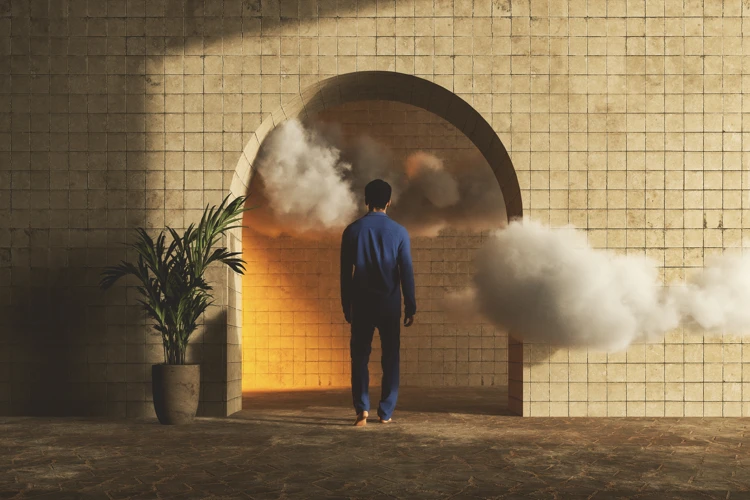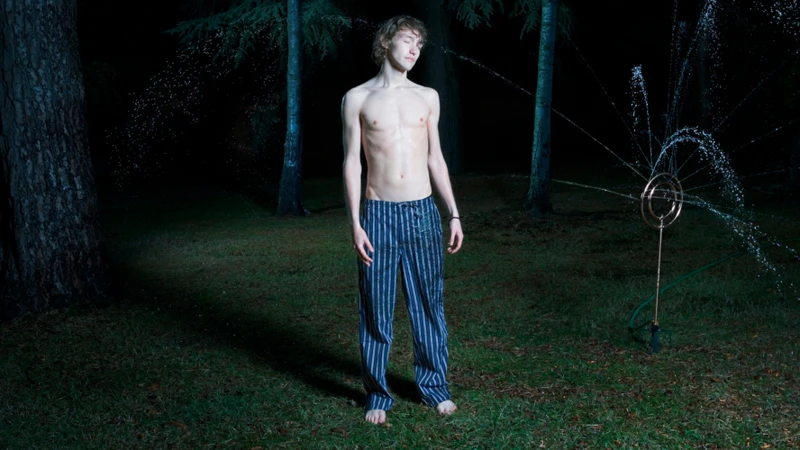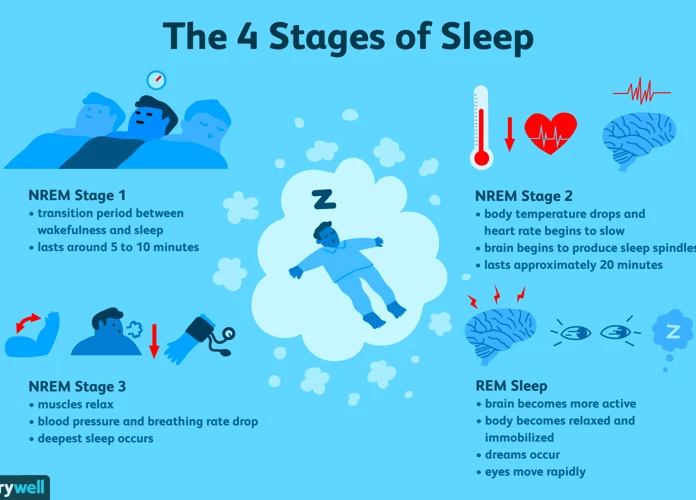Have you ever wondered what happens when dreams escape the realm of sleep? Sleepwalking, also known as somnambulism, is a fascinating phenomenon that bridges the gap between the subconscious mind and the physical world. It is a parasomnia disorder characterized by complex behaviors and actions during sleep. From wandering aimlessly to performing intricate tasks, sleepwalkers experience a state of altered consciousness that can both intrigue and perplex us. In this article, we will delve into the intricacies of sleepwalking, explore its connection to dreams, uncover the science behind it, and provide strategies for managing and ensuring safety during sleepwalking episodes.
What is Sleepwalking?

Sleepwalking, also known as somnambulism, is a parasomnia disorder characterized by complex behaviors and actions during sleep. It is more common in children but can also occur in adults. Sleepwalkers typically appear to be awake and may engage in activities such as walking, talking, or even driving, all while remaining asleep.
During a sleepwalking episode, individuals may have their eyes open but have a distant, vacant look on their faces. Their movements may be slow and clumsy, and their speech may be incoherent or nonsensical. Interestingly, sleepwalkers are often difficult to awaken and may have limited recollection of their actions upon awakening.
Despite common misconceptions, sleepwalking is not a result of acting out dreams. It occurs during the deepest stage of non-rapid eye movement (NREM) sleep, known as slow-wave sleep. Sleepwalking episodes can last from a few seconds to several minutes, and in rare cases, as long as an hour or more. Sleepwalkers may move around their sleep environment, or even leave the safety of their homes and walk outside.
The exact cause of sleepwalking is not fully understood, but it is believed to be influenced by a combination of genetic, environmental, and physiological factors. Certain medical conditions, medications, and sleep deprivation can also trigger sleepwalking episodes. To learn more about the causes and triggers of sleepwalking, click here.
Definition and Characteristics
Sleepwalking, also known as somnambulism, is a parasomnia disorder characterized by complex behaviors and actions during sleep. It is more prevalent in children, with the incidence peaking between the ages of 4 and 8, but it can also occur in adults.
During a sleepwalking episode, individuals typically have their eyes open but have a distant, vacant look on their faces. Their movements may be slow and clumsy, and their speech may be incoherent or nonsensical. Despite appearing to be awake, sleepwalkers are actually asleep and often difficult to awaken.
Sleepwalking episodes occur during the deepest stage of non-rapid eye movement (NREM) sleep, known as slow-wave sleep. They can last from a few seconds to several minutes, and in rare cases, as long as an hour or more. Sleepwalkers may move around their sleep environment, and some may even leave the safety of their homes and walk outside.
It is important to note that sleepwalkers typically have limited recollection of their actions upon awakening. They often have no memory of the sleepwalking episode, or their recollection may be fragmented and unclear.
To understand the relationship between sleepwalking and dreaming, continue reading about it here.
Prevalence and Causes
Sleepwalking is more common in children, particularly between the ages of 4 and 8, although it can occur in adults as well. It tends to run in families, suggesting a genetic component to the disorder. Studies have shown that if one or both parents have a history of sleepwalking, their children are more likely to experience it as well.
Several factors can contribute to the onset of sleepwalking. Some common causes include:
- Sleep deprivation: Lack of adequate sleep can increase the likelihood of sleepwalking episodes. It is important to establish healthy sleep habits and ensure sufficient rest.
- Stress and anxiety: Emotional stress and anxiety can disrupt the sleep cycle and trigger sleepwalking in susceptible individuals.
- Medical conditions: Certain medical conditions, such as sleep apnea, restless leg syndrome, and nocturnal seizures, have been associated with sleepwalking.
- Medications: Some medications, including sedatives, stimulants, and certain antidepressants, can increase the risk of sleepwalking.
- Environmental factors: Sleepwalking may be more likely to occur in unfamiliar sleep environments or during periods of travel.
It is important to note that while these factors may increase the risk of sleepwalking, not everyone with these factors will experience sleepwalking episodes. Sleepwalking remains a complex and multifaceted disorder with various contributing factors.
To learn more about how to manage and ensure safety during sleepwalking episodes, visit our article on sleepwalking safety measures.
The Connection between Sleep and Dreams

Throughout history, dreams have captivated human curiosity and have been subject to various interpretations and theories. Dreams occur during the rapid eye movement (REM) stage of sleep, which is characterized by vivid and immersive experiences. During REM sleep, our brains become highly active, and it is during this stage that most dreams take place.
Understanding the Dreaming Stage
REM sleep is a crucial part of the sleep cycle and typically occurs multiple times throughout the night. During this stage, our eyes move rapidly from side to side, muscles become temporarily paralyzed, and brain activity resembles that of a waking state. It is within this dream stage that we experience a wide range of emotions, images, sensations, and narratives that often feel real and vivid.
Scientists and psychologists have proposed numerous theories to explain the purpose and function of dreams. Some believe that dreams act as a way for the brain to process and consolidate emotions, memories, and experiences from the day. Others suggest that dreaming helps with problem-solving, creativity, and the integration of new information.
The Role of Dreams in Sleepwalking
While sleepwalking occurs during non-REM sleep, there is still a connection between sleepwalking and dreams. It is believed that the interactions between various stages of sleep can influence the occurrence of sleepwalking episodes. For example, disruptions in REM sleep or irregular sleep patterns can increase the likelihood of sleepwalking. In some cases, sleepwalkers may act out fragments of their dreams, which can lead to complex and potentially dangerous behaviors.
However, it’s important to note that most sleepwalking episodes do not involve elaborate dream scenarios. Instead, they often consist of aimless wandering or simple repetitive actions. The exact relationship between dreams and sleepwalking is still not fully understood and further research is needed to unravel this intriguing connection.
Understanding the Dreaming Stage
In order to understand the connection between sleepwalking and dreams, it is important to first explore the role of dreams themselves, particularly during the dreaming stage of sleep. This stage is known as rapid eye movement (REM) sleep, which is characterized by rapid eye movements, increased brain activity, and vivid dreaming.
During REM sleep, the brain enters a highly active state, with brainwaves resembling those of wakefulness. It is during this stage that dreams occur, often vivid and emotionally intense. The content of dreams can vary greatly, ranging from realistic scenarios to bizarre or fantastical experiences.
Research suggests that dreaming serves a variety of functions. It is believed to play a role in processing emotions, consolidating memories, and aiding in creativity and problem-solving. Dreams often draw upon elements from our daily lives, reflecting our thoughts, feelings, and experiences.
The dreaming stage is characterized by a temporary paralysis of the body’s voluntary muscles, known as REM atonia. This paralysis prevents the acting out of dream content, allowing us to remain immobile and safe during REM sleep. However, in individuals with sleepwalking, the usual mechanisms that keep the body paralyzed during REM sleep may be disrupted, leading to motor activity and sleepwalking behaviors during these dream-filled episodes.
To learn more about the intricate relationship between sleepwalking and dreaming, you can read our article here.
The Role of Dreams in Sleepwalking
While the exact relationship between sleepwalking and dreams is still not fully understood, there is evidence to suggest that dreams play a role in sleepwalking episodes. Dreams typically occur during a stage of sleep known as rapid eye movement (REM) sleep, which is different from the stage in which sleepwalking occurs. However, some research suggests that sleepwalkers may experience a disruption in the normal sleep cycle, causing their REM sleep and non-REM sleep stages to overlap.
During these overlapping stages, it is possible for dreams to influence sleepwalking behaviors. Sleepwalkers may act out elements of their dreams, incorporating them into their sleepwalking actions. For example, a dream about running from a perceived threat could manifest as actual running during a sleepwalking episode.
It is important to note that not all sleepwalking episodes are directly connected to dreams. Sleepwalkers may also engage in automatic behaviors that do not appear to be related to their dream content. These actions can include simple tasks like moving furniture or rearranging objects. The precise mechanisms underlying the interaction between dreams and sleepwalking are still being studied, and further research is needed to fully understand the role of dreams in sleepwalking.
Exploring Sleepwalking Episodes

Sleepwalking episodes can manifest in various behaviors, ranging from simple to complex actions. Some common behaviors observed during sleepwalking include:
- Walking or wandering aimlessly: Sleepwalkers may get out of bed and walk around their sleep environment. They often move slowly and clumsily, with a blank expression on their face.
- Talking or mumbling: Sleepwalkers may engage in conversations or mumble incoherently. Their speech may be hard to understand and have no logical connection to their surroundings.
- Performing routine actions: In some cases, sleepwalkers may perform tasks they would normally do while awake, such as eating, getting dressed, or even cooking. However, their actions tend to lack precision and awareness.
- Expression of fear or agitation: Sleepwalkers may exhibit signs of fear or agitation during an episode, possibly due to disorientation or confusion.
- Complex activities: Although less common, some sleepwalkers may engage in more complex activities during sleepwalking episodes, such as driving, leaving the house, or even violent behaviors.
Recognizing sleepwalking can sometimes be tricky, as the sleepwalker may not appear fully awake and may have limited memory of the episode. However, some signs that may indicate sleepwalking include:
- Walking or moving around during sleep: If someone is observed walking or moving around while asleep, it could be a sign of sleepwalking.
- Incoherent speech: If someone is speaking in a confused or nonsensical manner during sleep, it may indicate a sleepwalking episode.
- Confusion upon awakening: Sleepwalkers often feel confused, disoriented, or have no memory of their actions upon awakening.
- Multiple episodes: Sleepwalking tends to occur repeatedly, so if someone experiences recurrent episodes of walking or doing activities during sleep, it may indicate sleepwalking.
In most cases, sleepwalking is considered harmless and does not require medical intervention. However, it is advisable to seek medical help if sleepwalking episodes:
- Occur frequently: If sleepwalking episodes happen frequently or disrupt the individual’s quality of sleep, consulting a healthcare professional is recommended.
- Pose a risk of injury: Sleepwalkers who engage in complex or potentially dangerous activities, such as leaving the house or cooking, may be at risk of harm and should seek medical attention.
- Lead to daytime impairment: If sleepwalking causes excessive daytime sleepiness, fatigue, or interferes with daily functioning, it is essential to consult a doctor.
Common Behaviors during Sleepwalking
Sleepwalking is characterized by a variety of behaviors that can range from simple and repetitive to more complex and dangerous. While each individual’s sleepwalking experience may differ, there are a few common behaviors often associated with sleepwalking episodes:
- Walking and Moving Around: As the name suggests, sleepwalkers typically engage in walking or moving around during a sleepwalking episode. They may wander aimlessly throughout the house or even venture outside.
- Talking or Mumbling: Sleepwalkers may engage in conversations, mutter, or make incomprehensible sounds during their episodes. Their speech may be difficult to understand or lack coherence.
- Performing Routine Activities: It is not uncommon for sleepwalkers to engage in routine activities while asleep. This can include tasks such as getting dressed, making a bed, or tidying up the room.
- Opening and Closing Doors: Sleepwalkers may exhibit behaviors like opening and closing doors repeatedly, as if searching for something or trying to navigate through the environment.
- Eating and Drinking: Some sleepwalkers may raid the kitchen and consume food or drink while sleepwalking, often without any memory of doing so.
- Engaging in Inappropriate Behavior: In rare cases, sleepwalkers may display inappropriate behavior during their episodes, such as urinating in inappropriate places or engaging in sexual acts.
It is important to note that sleepwalkers are in a state of altered consciousness and are not aware of their actions. They may have a blank or glassy expression on their face, and attempts to communicate with them may be unsuccessful or met with confusion. Understanding these common behaviors can help recognize sleepwalking episodes and take necessary precautions to ensure the safety of the sleepwalker. To learn more about sleepwalking safety measures, click here.
Recognition and Diagnosis
Recognition and diagnosis of sleepwalking can often be challenging as it mostly occurs during sleep, making it difficult for individuals to be aware of their own behavior. However, there are certain signs and indicators that can help in identifying sleepwalking episodes:
- Observation by others: Sleepwalking is often noticed by family members or bed partners who witness the episodes or find the sleepwalker in a different location.
- Abnormal behavior during sleep: Sleepwalkers may exhibit unusual behaviors such as sitting up in bed, walking around, mumbling, or performing routine tasks while still asleep.
- Incomplete recollection: Upon waking up from a sleepwalking episode, the individual may have little to no memory of the event.
If you suspect that you or someone you know may be experiencing sleepwalking episodes, it is advisable to seek medical evaluation for a proper diagnosis. A healthcare professional will take a detailed medical history, inquire about sleep patterns, and may even recommend the use of sleep monitoring devices. These measures can help confirm the presence of sleepwalking and rule out other underlying sleep disorders.
When to Seek Medical Help
Knowing when to seek medical help for sleepwalking is important in order to address any underlying issues and ensure the safety and well-being of the individual experiencing sleepwalking episodes. While occasional sleepwalking is generally harmless, there are certain situations in which medical attention should be sought:
- If the sleepwalking episodes are frequent, disruptive, and affecting the quality of sleep.
- If the sleepwalker is at risk of injury or is engaging in dangerous behaviors during episodes.
- If the sleepwalking episodes are accompanied by other concerning symptoms, such as daytime sleepiness, difficulty concentrating, or mood disturbances.
- If the sleepwalker has a history of sleep disorders or has a family history of sleepwalking.
- If the sleepwalking episodes appear to be a new occurrence in adulthood.
It is important to consult a healthcare professional who specializes in sleep disorders, such as a sleep medicine physician or a neurologist, in order to receive an accurate diagnosis and appropriate treatment. The healthcare provider will evaluate the individual’s medical history, conduct a physical examination, and may recommend further tests or a sleep study to gather more information about the sleepwalking episodes.
Treatment for sleepwalking typically focuses on managing any underlying conditions, improving sleep hygiene, and implementing safety measures to reduce the risk of injury during sleepwalking episodes. To learn more about sleepwalking safety measures, click here.
The Science Behind Sleepwalking

Understanding the science behind sleepwalking can help shed light on this intriguing phenomenon. While the exact mechanisms are not fully understood, researchers have uncovered several theories that explain the neurological, genetic, and environmental factors associated with sleepwalking.
Neurological explanations suggest that sleepwalking may be caused by an imbalance in neurotransmitters or the disruption of normal brain activity during sleep. Studies have shown that certain regions of the brain, such as the frontal cortex, play a significant role in sleepwalking. Dysfunction in these areas can lead to the dissociation between consciousness and motor behavior, characteristic of sleepwalking.
Genetic factors also contribute to the likelihood of experiencing sleepwalking. It has been found that sleepwalking tends to run in families, indicating a genetic predisposition. Specific genes related to sleep regulation and arousal mechanisms have been identified as potential culprits. Further research is needed to fully understand the genetic basis of sleepwalking.
Environmental triggers can play a role in sleepwalking episodes as well. Factors such as sleep deprivation, irregular sleep schedules, increased stress, certain medications, and alcohol consumption can increase the likelihood of sleepwalking. Understanding and managing these triggers can help minimize the occurrence of sleepwalking episodes.
By unraveling the intricate science behind sleepwalking, we can gain a deeper understanding of this mysterious sleep disorder. This understanding may ultimately lead to more effective treatment and prevention strategies to help those who experience sleepwalking episodes.
Neurological Explanations
Neurological explanations provide insight into the underlying mechanisms of sleepwalking. Studies suggest that abnormalities within the brain’s electrical activity and the areas responsible for sleep regulation and motor control may contribute to the occurrence of sleepwalking.
One theory proposes that sleepwalking is associated with a dysfunction in the frontal lobe of the brain, which is responsible for higher-order cognitive functions, decision-making, and motor control. It is thought that during sleepwalking episodes, the inhibitory mechanisms that normally keep our physical actions in check become impaired, leading to the manifestation of unconscious motor behaviors.
Another neurological explanation points to an imbalance in neurotransmitters, particularly serotonin and dopamine, which play crucial roles in sleep-wake regulation and motor coordination. Disruptions in these neurotransmitter systems may disrupt the synchronization between different brain regions during sleep, contributing to sleepwalking episodes.
Additionally, there is evidence to suggest that sleepwalking can be linked to underlying sleep disorders, such as sleep apnea or restless leg syndrome. These disorders can cause disturbed sleep patterns and fragmented sleep, further increasing the risk of sleepwalking episodes.
Understanding the neurological factors involved in sleepwalking is essential for developing effective treatments and preventive strategies. However, it is important to note that further research is still needed to fully unravel the intricacies of sleepwalking and its neurological underpinnings.
Genetic Factors
Genetic factors play a significant role in sleepwalking. Research suggests that if one or both parents have a history of sleepwalking, their children have a higher likelihood of experiencing sleepwalking episodes as well. Studies have identified specific genes that may be associated with this sleep disorder, although the exact mechanisms are still being explored.
A genetic predisposition does not guarantee that an individual will sleepwalk, but it increases the susceptibility. There may be certain variations or mutations in genes that contribute to the regulation of sleep and wake cycles, leading to a higher risk of sleepwalking. However, it is important to note that sleepwalking is a complex condition influenced by multiple genetic and environmental factors.
Family studies have shown that sibling and twin concordance rates for sleepwalking are higher compared to the general population, further supporting the role of genetics. In some cases, sleepwalking can run in families for generations, indicating a strong hereditary component.
While genetic factors are an important aspect, they do not act alone. Environmental factors and triggers can also influence the occurrence of sleepwalking episodes. To learn more about the environmental triggers of sleepwalking, click here.
Environmental Triggers
Environmental factors can play a significant role in triggering sleepwalking episodes. Certain sleep environments or external stimuli can disrupt the normal sleep patterns and contribute to sleepwalking behaviors. Here are some common environmental triggers:
- Stress: Stressful situations or events, such as exams, work pressure, or personal conflicts, can affect sleep and increase the likelihood of sleepwalking. Stress management techniques, such as relaxation exercises or therapy, may help alleviate these triggers.
- Sleep Deprivation: Lack of adequate sleep can disrupt the normal sleep-wake cycle and increase the chances of sleepwalking. Maintaining a consistent sleep schedule and practicing good sleep hygiene can help prevent sleep deprivation as an environmental trigger.
- Noise or Light: Loud noises, bright lights, or sudden changes in the sleep environment can startle sleepwalkers and trigger episodes. Creating a quiet and dimly lit sleep environment can help minimize these triggers.
- Physical Discomfort: Uncomfortable temperatures, an uncomfortable mattress, or other physical discomforts can disrupt sleep and contribute to sleepwalking. Ensuring a comfortable sleep environment can reduce the likelihood of these triggers.
- Alcohol and Substance Use: Certain substances, including alcohol and certain medications, can interfere with normal sleep patterns and contribute to sleepwalking. Avoiding alcohol and discussing potential medication interactions with a healthcare professional can help mitigate these triggers.
Identifying and addressing environmental triggers can be an essential step in managing sleepwalking episodes. By creating a sleep-friendly environment and minimizing potential disruptions, individuals can reduce the frequency and severity of sleepwalking incidents. For more information on managing sleepwalking and ensuring safety, click here.
Managing Sleepwalking and Ensuring Safety
Dealing with sleepwalking can be a challenging task, but there are several strategies you can implement to manage sleepwalking episodes and ensure the safety of the sleepwalker:
- Create a Safe Sleep Environment: Make sure the sleepwalker’s bedroom is free of hazards that could potentially cause injury. Remove sharp objects, secure windows and doors, and use baby gates or alarms to prevent the sleepwalker from leaving the house without being aware. Consider placing padding on the floor or around the bed to soften any potential falls.
- Establish a Consistent Sleep Schedule: Maintaining a regular sleep schedule can help regulate sleep patterns and reduce the likelihood of sleepwalking. Aim for an adequate amount of sleep each night and establish a relaxing bedtime routine.
- Implement Good Sleep Hygiene: Encourage good sleep habits by avoiding caffeine and stimulating activities close to bedtime. Create a calm and comfortable sleep environment, with dim lighting, a comfortable mattress, and a cool temperature.
- Minimize Stress: Stress can exacerbate sleepwalking, so it’s important to help the sleepwalker manage stress and anxiety. Encourage regular exercise, relaxation techniques, and open communication to address any underlying emotional issues.
- Consider Medical Intervention: If sleepwalking episodes are frequent, disruptive, or pose a significant risk to the sleepwalker’s safety, it may be necessary to seek medical help. A sleep specialist can assess the situation, perform a sleep study if needed, and recommend appropriate interventions such as medication or therapy.
By implementing these strategies, you can minimize the impact of sleepwalking episodes and promote a safe sleep environment for the sleepwalker. For more detailed information on sleepwalking safety measures, visit our article on sleepwalking safety measures.
Creating a Safe Sleep Environment
Creating a safe sleep environment is crucial for individuals who experience sleepwalking episodes. Taking proactive measures can help prevent injuries and ensure the well-being of sleepwalkers. Here are some strategies to consider:
- Remove Potential Hazards: Clear the sleep environment of objects that could be tripped over or dropped, such as furniture, electrical cords, or loose rugs. Secure windows and doors to prevent sleepwalkers from accidentally wandering outside.
- Use Safety Gates or Alarms: For individuals prone to more severe sleepwalking episodes, installing safety gates at the top of stairs or using alarms on doors can help prevent access to potentially dangerous areas.
- Keep the Bedroom Clutter-Free: A clutter-free bedroom reduces the risk of falls or collisions during sleepwalking episodes. Keep the floor clear of any objects that may pose a hazard.
- Consider Sleepwalking Monitors: Sleepwalking monitors, such as bed alarms or motion-sensor devices, can alert caregivers when a sleepwalker is on the move, allowing for prompt intervention and assistance.
- Ensure Adequate Lighting: Having effective lighting in hallways and bedrooms can help sleepwalkers navigate their surroundings more safely. Consider using nightlights or motion-sensor lights to provide illumination.
It is important to involve healthcare professionals or sleep specialists for personalized guidance in creating a safe sleep environment. They can provide specific recommendations based on the individual’s sleepwalking patterns and behaviors to ensure the best possible safety measures. To learn more about sleepwalking safety measures, click here.
Managing Stress and Improved Sleep Hygiene
Managing stress and incorporating good sleep hygiene practices into your routine are essential for preventing and managing sleepwalking episodes. Stress can disrupt sleep patterns and increase the likelihood of sleepwalking. It is crucial to find healthy ways to manage stress levels. Consider incorporating stress-reduction techniques, such as deep breathing exercises, meditation, or yoga, into your daily routine. Engaging in regular physical exercise can also help reduce stress and contribute to better sleep.
Another important aspect of managing stress and improving sleep hygiene is establishing a consistent bedtime routine. Create a relaxing atmosphere in your bedroom by keeping it dark, quiet, and cool. Avoid stimulating activities, such as using electronic devices or watching TV, before bed, as these can interfere with your ability to fall asleep. Instead, opt for calming activities like reading a book, taking a warm bath, or listening to soothing music.
Establishing a regular sleep schedule is also crucial. Try to go to bed and wake up at the same time every day, even on weekends. This helps regulate your body’s internal clock and promotes better sleep quality. Avoid consuming caffeine, nicotine, and alcohol close to bedtime, as these substances can disrupt sleep patterns.
Creating a comfortable sleep environment is equally important. Invest in a supportive mattress and pillows, and choose breathable bedding to help regulate body temperature. Additionally, keep your room well-ventilated and free from excessive noise, as these factors can disrupt sleep and increase the likelihood of sleepwalking episodes.
By managing stress and practicing good sleep hygiene, you can create an optimal sleep environment that promotes restful sleep and reduces the occurrence of sleepwalking episodes. For more information on sleepwalking safety measures, click here.
Conclusion
Sleepwalking is a fascinating phenomenon that highlights the complex interplay between the mind and body during sleep. While its exact cause remains elusive, understanding the characteristics, prevalence, and potential triggers of sleepwalking can help individuals and their loved ones better manage and navigate this condition.
Recognizing the signs of sleepwalking and creating a safe sleep environment are crucial steps in minimizing the risks associated with sleepwalking episodes. Additionally, implementing stress management techniques and improving sleep hygiene can contribute to overall better sleep quality and reduce the likelihood of sleepwalking episodes.
Although sleepwalking can be alarming, it is essential to approach it with empathy and support for those affected. Consulting with healthcare professionals and sleep specialists can provide further insights and strategies for individuals experiencing persistent or disruptive sleepwalking episodes.
In conclusion, awareness and education about sleepwalking can help dispel misconceptions, foster understanding, and promote a sense of safety and well-being for those affected by this intriguing sleep disorder.
Frequently Asked Questions
1. Can sleepwalking be dangerous?
Yes, sleepwalking can potentially be dangerous. Sleepwalkers may unknowingly engage in activities that put them at risk of injury, such as walking down stairs, opening windows, or even leaving the house.
2. What triggers sleepwalking episodes?
Sleepwalking episodes can be triggered by various factors, including sleep deprivation, stress, fever, certain medications, and alcohol consumption. Identifying and minimizing these triggers can help reduce the frequency of sleepwalking episodes.
3. Are sleepwalking and night terrors the same thing?
No, sleepwalking and night terrors are not the same. While they both fall under the category of parasomnias, night terrors are intense episodes of fear or panic during sleep, whereas sleepwalking involves physical activity and movement during sleep.
4. Should I wake someone up if they are sleepwalking?
It is generally advised not to wake up a sleepwalker abruptly, as it can startle or confuse them. It is safer to gently guide them back to bed without fully waking them. However, if the sleepwalker is in immediate danger, such as being near a hazardous object or area, it may be necessary to wake them up.
5. Can sleepwalking be treated with medications?
In some cases, doctors may prescribe medication to treat sleepwalking, particularly if it poses a significant risk to the individual or disrupts their sleep. However, medication is not always necessary, and other treatment approaches, such as addressing underlying stress or improving sleep hygiene, may be effective.
6. Can children outgrow sleepwalking?
Yes, many children tend to outgrow sleepwalking as they transition into adolescence. The exact age at which sleepwalking resolves can vary from person to person. However, if sleepwalking persists into adulthood or causes significant disruption, it is advisable to seek medical advice.
7. Can sleepwalking be inherited?
There is evidence to suggest that sleepwalking can have a genetic component. If one or both parents have a history of sleepwalking, their children may be more likely to experience sleepwalking as well.
8. Can sleepwalking be prevented?
While sleepwalking cannot always be prevented, certain measures can help reduce the likelihood of episodes. Ensuring a safe sleep environment, maintaining a regular sleep schedule, and managing stress levels can all contribute to minimizing the occurrence of sleepwalking episodes.
9. Is sleepwalking a sign of a serious sleep disorder?
Sleepwalking itself is not considered a serious sleep disorder. However, it can be a symptom of an underlying sleep disorder, such as sleep apnea or restless leg syndrome. If sleepwalking is a frequent occurrence or is accompanied by other concerning symptoms, it is recommended to consult with a healthcare professional.
10. Can sleepwalking be remembered?
Sleepwalkers often have limited or no memory of their actions during a sleepwalking episode. Upon awakening, they may have vague recollections or no recollection at all of what occurred while sleepwalking.








